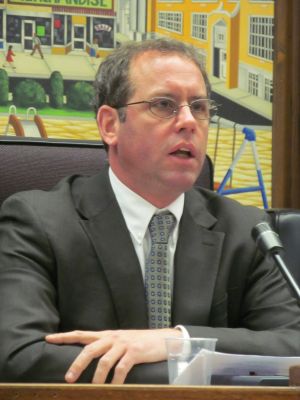New Hyde Park Mayor Robert Lofaro said Tuesday the village will remain opposed to a third track on the Long Island Rail Road’s Main Line unless plans include the elimination of street-level crossings.
The crossings at New Hyde Park Road, Covert Avenue and South 12th Street are already down almost 45 minutes during rush hours each day, Lofaro said.
“If you’re going to put a third track and add additional capacity and you’re not going to eliminate the grade crossings, forget about going down Covert Avenue or New Hyde Park Road any time between six in the morning and 10 in the morning, because those gates are going to be down constantly,” he said.
While LIRR President Patrick Nowakowski and other Metropolitan Transportation Authority officials were receptive to the concern in a meeting with New Hyde Park’s LIRR task force last week, Lofaro said they gave no specific plans for the the third track.
MTA LIRR spokesman Salvatore Arena said in a statement the railroad is in the process of hiring a consultant to conduct an environmental study.
“This review will include significant community outreach to inform Long Islanders about the project, including an examination of the future of all seven grade crossings along the corridor,” Arena said.
The MTA and Gov. Andrew Cuomo announced plans in January to put a third track along 9.8 miles of the Main Line between Floral Park and Hicksville. The project is expected to cost between $1 billion and $1.5 billion.
Proponents — including the Association for Better Long Island, which endorsed the project this week — say a third track would increase LIRR efficiency and create potential for economic growth on Long Island by encouraging reverse-commuting from New York City.
The LIRR broke a ridership record last year with 87.6 million customers, which indicates the need for a third track, Nowakowski said this week.
“Looking toward the future, we’re pleased that we’re poised to increase our value to the region further, and grow ridership accordingly, through increased reverse-peak service that would result years down the road from the Main Line Expansion program that Gov. Cuomo announced this month,” Nowakowski said in an MTA statement on ridership numbers Tuesday.
The plan has drawn concerns from villages along the Main Line, including New Hyde Park, Floral Park and Mineola, who derailed a third track proposal in the mid-2000s.
In addition to New Hyde Park’s concerns about grade crossings, villages worry extended construction and the estimated 50 property acquisitions would adversely affect residents and could disrupt commerce.
“It’s great that the Long Island community is growing and so on, but not on our backs,” Lofaro said in an interview.
Arena said the LIRR will continue meeting with elected officials to show how the new plan “significantly minimizes the need for property acquisition beyond the railroad right-of-way.”



